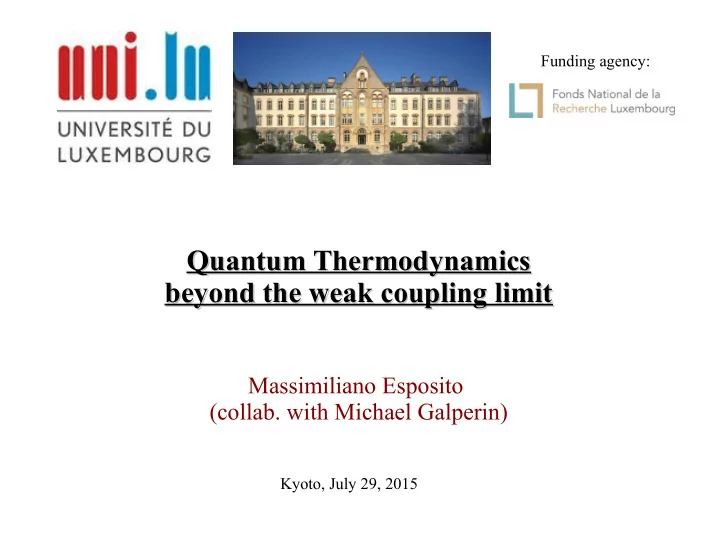

Funding agency: Quantum Thermodynamics Quantum Thermodynamics beyond the weak coupling limit beyond the weak coupling limit Massimiliano Esposito (collab. with Michael Galperin) Kyoto, July 29, 2015
Introduction Introduction Thermodynamics in the 19th century: Thermodynamics in the 21th century: http://www.scm.com/ 2
Outline Outline I) Nonequilibrium Thermodynamics: Phenomenology II) Weak coupling: Stochastic Thermodynamics III) Strong coupling: An exact identity as the second law IV) Strong coupling with NEGF: A) Model and dynamics B) Problems with conventional heat definitions C) A new approach to Quantum Thermodynamics Open questions 3
I) Nonequilibrium Thermodynamics: Phenomenology Res2 Res1 Sys Zeroth law: Existence of equilibrium with a well defined temperature First law: Second law: Third law: when Reversible transformation: (slow trsf. in contact with one reservoir) Fundamental relation of equilibrium thermodynamics 4
II) Stochastic Thermodynamics (weak coupling) II) Stochastic Thermodynamics (weak coupling) Esposito, Stochastic thermodynamics under coarse-graining , PRE 85 , 041125 (2012) Van den Broeck and Esposito, Ensemble and Trajectory Thermodynamics: A Brief Introduction , Physica A 418 , 6 (2015) Res2 Res1 Microscopically derived Markovian Quantum Master Equation Sys + rotating wave approx are the eigenenergies of the system Different reservoirs Local detailed balance : Energy Particle number Shannon entropy 5
Matter conservation Energy and Matter currents Heat 1st law: (energy conservation) Mechanical work Chemical work 2nd law: (non-conservation of entropy) iff (detailed balance = equilibrium) 0th law: 3rd law: 6
Stochastic thermodynamics for open quantum systems also works for: Rapid periodic driving (Floquet theory + weak coupling) : quasienergies of the system Mech. work due to driving "Stochastic thermodynamics of rapidly driven systems", Bulnes Cuetara, Engel & Esposito, New J. Phys. 17 , 055002 (2015) Non-additive in the reservoirs “Strong couping” with polaron transformation "Single electron transistor strongly coupled to vibration: counting statistics and fluctuation theorem", Schaller, Krause, Brandes & Esposito, New J. Phys. 15 , 033032 (2013) "Thermodynamics of the polaron master equation at finite bias", Krause, Brandes, Esposito & Schaller, 7 J. Chem. Phys. 142 , 134106 (2015)
III) An exact identity (strong coupling) Res1 Res2 Entropy production as correlation between system and reservoir Esposito, Lindenberg, Van Den Broeck, New J. Phys. 12 , 013013 (2010) Sys Single assumption: 1st law: 2nd law: Energy: Entropy: Heat: Work: 8 See also Reeb & Wolf, New J. Phys. 16 , 103011 (2014)
Problems can be negative at finite N as well as at infinite N! No zeroth law “build in” the dynamics No third law because no equilibrium entropy Entropy Production in Quantum Brownian Motion, Entropy production as correlation between system Pucci, Esposito, Peliti, J. Stat. Mech. (2013) P04005 and reservoir, Esposito, Lindenberg, Van Den Broeck, New J. Phys. 12 , 013013 (2010) 9
IV) NEGF (strong coupling) A) Model and dynamics Externally driven single level quantum dot strongly coupled to Fermionic reservoirs Res2 Res1 Sys 10
Contour System Green's functions: Fourier trsf Equations of motion Self-energies (effect of the reservoirs) expanded to second order Slow driving: “Gradient expansion” 11
B) Problems with conventional heat definitions Esposito, Ochoa, Galperin, On the nature of heat in strongly coupled open quantum systems, arXiv:1408.3608 to be replaced soon the interaction is part of the system this is the standard definition equal sharing of the interaction between reservoir and system the interaction is part of the reservoir : Fermi distribution Reversible heat: Retarded GF: Lamb shift Broadening Retarded self-energy: Spectral function: 12
Reversible heat has to be an exact differential: This is only true if ! We can obtain entropy by integrating: Energy resolved Shannon form Zero in wide band approx. 13 Problems with third law: When
C) A new approach to quantum thermodynamics Quantum thermodynamics: A nonequilibrium Green's function approach Esposito, Ochoa & Galperin, Phys. Rev. Lett. 114 , 080602 (2015). Equation of motion for the population of the level : Retarded Green's functions: Self-energy: Broadening Lamb shift Spectral function: Energy resolved particle current: 14
Renormalized spectral function: is positive and normalized Energy resolved quantities! where Introduced in the context of the quantum Boltzmann equation by Ivanov, Knoll, and Voskresensky, Nuclear Physics A 672, 313 (2000) 15
First law Balance equations: Second law Particle current Heat Energy current Chemical work Mechanical work Entropy production Equilibrium: 16
Weak coupling limit we recover stochastic thermodynamics 0th law: At equilibrium the Fermi distribution at 3rd law: At nonequilibrium steady state: Standard definitions! For reversible transformations: 17
Remark 18
(reversible heat) is not a state function But: can be negative Special case where it works: 1 level, 1 reservoir, wide band, no driving in coupling Ludovico, Lim, Moskalets, Arrachea, Sanchez, Phys. Rev. B 89, 161306 (2014) 19
Open questions Open questions Generalization to many orbitals and to interacting systems.... Beyond gradient expansion (for faster driving).... Fluctuations.... Experiments.... Main references: Esposito, Lindenberg, Van Den Broeck, Entropy production as correlation between system and reservoir, New J. Phys. 12 , 013013 (2010) Esposito, Ochoa and Galperin, Quantum thermodynamics: A nonequilibrium Green's function approach, Phys. Rev. Lett. 114 , 080602 (2015) On the nature of heat in strongly coupled open quantum systems, arXiv:1408.3608 to be replaced soon Thank you for your attention! 20
Recommend
More recommend